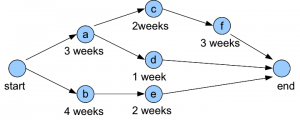The mysterious critical path notion seems to put project managers in difficulty and especially the novice ones. However if anyone would take just a few minutes from his precious time to pay a closer attention to it things would be a lot more clear.
The origin
In order to clear things up we need to have a background knowledge. On short it all started with the Critical Path Method (CPM) an algorithm for scheduling activities within a project. This method is best used within the project scheduling phase and basically it requires to construct a model of the project that includes:
- the list of activities needed to complete the project (aka Work Breakdown Structure defined in the project planning phase)
- the duration estimates for these activities
- the dependencies between the tasks
Graphical representation
There are two possibilities to render the structure created according to CPM: activity on arrow and activity on node. The most used representation nowadays is the activity on node. The activities are rendered as nodes and each node contains the duration of that activity while the dependencies are rendered as arrows where the arrowhead points to the successor while the tail to the predecessor.
To some extent a Gantt chart can also be considered as a CPM presentation although a more complex one.
The critical path
Simply put the critical path is represented by all the tasks that determine the end date of the project. The tasks from that path are called critical tasks. If any of those tasks is delayed, then the project end date would also be delayed. However not all the tasks from the project are on the critical path. This happens due to the slack of the project. The slack is the amount of time a task can be delayed without indirectly impacting the end date of the project. The critical path methodology is simply a technique to identify all the tasks that will directly impact the project end date.

Use within the project tracking phase
Once the project manager establishes the project plan and the critical path is identified things are not finished. During the tracking phase of the project changes may occur and this might influence the critical path. For this reason the managers must always keep an eye on the critical path and its evolution. Even the smallest change in the duration of a task can completely change it.
A schedule generated using critical path technique is often not too precise because estimations are used to compute it. For projects with a higher level of uncertainty in their evolution a better alternative solution is the Project Evaluation and Review Technique (PERT). PERT is a variation on Critical Path Analysis that allows a range of durations to be specified for each activity. To use it, the manager should estimate the shortest, the most likely and the longest time that an activity can take to complete.
The critical path is a very useful tool for managers to keep projects within time and budget constraints. This is an essential feature that a project management software must have.
